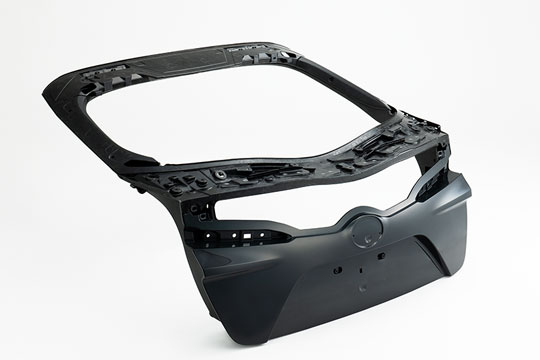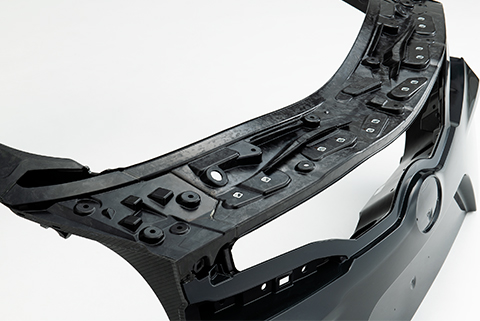Case Study
Automobiles
Background factors in the automotive market include increasingly rigorous fuel efficiency and carbon dioxide emission regulations, leading to increased interest in reducing the weight of vehicles.
Carbon fiber reinforced plastics (CFRP), which combine lightness and high strength, are therefore expected to be used for automotive components.
Here we introduce a case study of application to the back door of a passenger car.

Back Door:
With FMC (CF-SMC), the weight of the back door was successfully reduced.
The application of carbon fiber reinforced plastics (CFRP) in automobiles has been limited to luxury cars with limited production volumes, due to the time needed for production, and the cost of producing parts. However, using CF-SMC, we have achieved both weight reduction and productivity improvement, and we are now expanding the use of CF-SMC to mass-produced cars.
Success in reducing weight by approximately 40% in comparison with aluminum back doors
- Productivity is improved using rapid-curing materials.
- Favorable flow properties enable molding of parts with complex shapes.
- Using carbon fiber, we succeeded in reducing the weight by 40% in comparison with aluminum.
FMC (CF-SMC), which we have developed, is a type of intermediate material for carbon fiber reinforced plastics (CFRP). It is in the form of sheets, in which carbon fibers cut to lengths of several centimeters are dispersed in resin. Press molding enables processing of FMC to make parts in as little as 2 to 5 minutes. Compared to prepreg, which is an intermediate material made by impregnating continuous carbon fiber with resin, FMC offers the advantage of enabling the molding of parts with complex shapes. In addition, as its mechanical properties approximate to homogeneity, it is relatively easy to achieve weight reduction and high strength using carbon fiber with conventional component design techniques. CMC was selected due to being highly rated in the following respects: (i) it enables both major weight reduction and high performance of parts; (ii) it has excellent moldability, enabling production of parts with complex shapes; and (iii) it has the productivity required for mass production of automotive parts.
